I'm trying to solve the system of equations:
where a,b and c are columns from pandas dataframe. I used to work with Excel, where I run a macro with go seak in one column (residuals) by changing the values of the other columns (functions), but I don't know how to do that in Python, and I have asked here, but no answer yet.
I have tried fsolve, but the result is always my initial guess, so, I guess it needs some bounds, but fsolve doesn't allow the introduction of bounds, that's why I'm trying scipyn.NonlinearConstraint Below are the dataset and functions to solve:
import numpy as np
import pandas as pd
import scipy.optimize as opt
from scipy.optimize import NonlinearConstraint
a = np.linspace(300,400,30)
b = np.random.randint(700,18000,30)
c = np.random.uniform(1.4,4.0,30)
df = pd.DataFrame({'A':a, 'B':b, 'C':c})
def func(zGuess,*Params):
x,y,z = zGuess
a,b,c = Params
eq_1 = (((3.47-np.log10(y))**2+(np.log10(c)+1.22)**2)**0.5) - x
eq_2 = ((a/101.32) * (101.32/b)** z) - y
eq_3 = (0.381 * x + 0.05 * (b/101.32) -0.15) - z
return eq_1,eq_2,eq_3
zGuess = np.array([2.6,20.2,0.92])
up_bound = (9,np.inf,1.1)
low_bound = (0,-np.inf,0)
and here I try to solve with fsolve:
df['x'],df['y'],df['z'] = zip(*df.apply(lambda x: opt.fsolve(func,zGuess,args=(x['A'],x['B'],x['C'])),1) )
and here with Nonlinearconstraint:
df['x'],df['y'],df['z'] = zip(*df.apply(lambda x: NonlinearConstraint(func(zGuess,x['A'],x['B'],x['C']),low_bound,up_bound),1) )
but with Nonlinearconstraint it gives an error:
TypeError: zip argument #1 must support iteration
I have even tried to minimize over the pandas dataframe:
def func2(zGuess,*Params):
x,y = zGuess
a,b,c,n = Params
eq_1 = (((3.47-np.log10(y))**2+(np.log10(c)+1.22)**2)**0.5) - x
eq_2 = ((a/101.32) * (101.32/b)** n) - y
return eq_1,eq_2,eq_3
zGuess2 = np.array([2.6,20.2])
n = np.linspace(0,1.,500)
for i in n:
df['x'],df['y'] = zip(*df.apply(lambda x: opt.fsolve(func2,zGuess2,args=(x['a'],x['b'],x['c'],i)),1))
df['n_calc'] = df.apply(lambda x: (0.381 * x['x'] + 0.05 * (x['b']/101.32) - 0.15),1)
res = np.abs(df['n_calc'] - i)
if res <= 1e-5:
n_solver = i
df['n_solver'].append(n_solver)
I never thought something so simple like go seak in excel would give such difficulty to perform in python, I really need some help, please.
